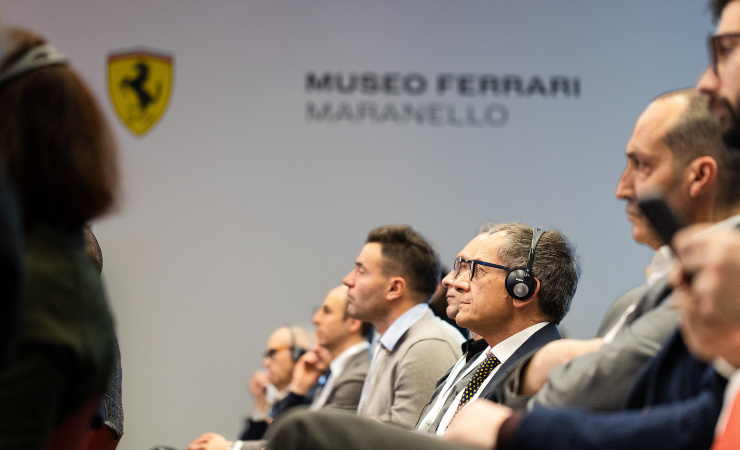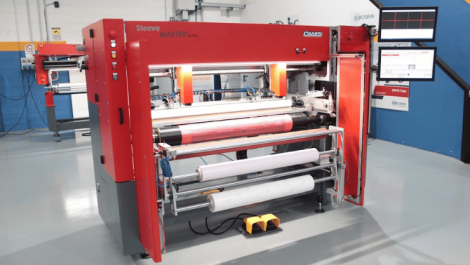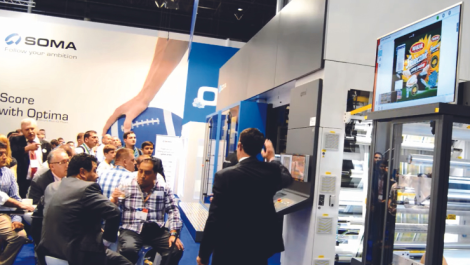The three-day Future of Flexo conference took place at the Museo Ferrari in Maranello, Italy, in February. Andy Knaggs reports on what he heard on Day One.
Fast cars and Big Data, turbo-charged repro and an impassioned plea for industry solidarity – this was the FlexoTech experience of the Future of Flexo conference, which took place in Italy over three days in February 2023.
Let us get the fast cars part out of the way first: the event took place at the Museo Ferrari in Maranello, near Bologna. This is the town to which Enzo Ferrari relocated his factory from Modena after bombing during the Second World War, around the time he also decided to start making cars bearing his own name for the first time. The rest, as they say, is history. A thrilling venue for petrolheads.
The event itself was hosted by Italian repro supplier Z Due and included three of its partners, all suppliers of technology or services to the flexo sector: repro company Reproflex3; plate and sleeve manufacturer Tamburini; and I&C Gama Group, which supplies solutions for ink quality control, plate mounting and dismounting, logistics and cleaning, and slitting and rewinding.
Each of these companies made presentations to an audience that was predominantly made up of Italian flexo printers and converters, and representatives of corporate organisations. These presentations we will return to, but what struck this listener most was a Q&A on stage with Alberto Palaveri, sales manager at the Milan-based flexible packaging company Sacchital, who is also the president of GIFLEX, the Italian association of flexible packaging converters.
No punches pulled
Asked by the moderator whether the EU Packaging & Packaging Waste regulations, which were recently elevated from optional guidelines to mandatory status, were the right solution to deliver a circular economy, Mr Palaveri seemed to pull no punches, judging by the English translation that shadowed his response.
‘I would say no, and here’s why,’ he began. ‘This regulation has not been approved yet. The process should be finished by the end of this year, but it can still be adjusted and improved. It’s important because this is about the future of packaging, and it’s not a directive anymore; it’s going to become law in every member state (of the EU). It aims to reduce the amount of packaging on the market and for the first time, packaging is defined as an evil to fight against. Political and technological choices are being deployed to fight against it.
‘We all make investments to be more efficient, more sustainable, but it’s also important to consider whether the products have a future in legislative terms. This is quite concerning. The decision makers have made a ‘do and not-to-do’ list that will become binding. We don’t know what will happen in a few years’ time, when there will be an update. When it comes to circular economy, very often we need to consider nature, because it’s the invisible member on any board.’
Mr Palaveri was next asked about the challenges of doing business in the current geopolitical situation, but he was quickly back on his theme of the harsh spotlight that packaging now operates within.
He said, ‘There’s a major paradigm change happening in packaging. The materials that have characterised our sector for years will disappear, and we are a business that’s going to change radically. The market is telling us that some of the things we manufacture don’t fit any more. There’s a shift with materials – paper is not always (looked upon) the same as it used to be. We need to consider that.’
There followed some Italian flexo sector introspection, regarding the desirability of packaging printers and converters collaborating more, sharing knowledge, and joining together so that lobbying of the political masters can be made more effective. But Mr Palaveri had already made a clarion call of more general packaging industry relevance before this.
‘The regulators are recently telling us that packaging is evil,’ he said. ‘We should try to disseminate the good things that our industry does, and put good things into the media about the positive things we do.’
Efficiency the goal
Earlier in the day’s schedule, the conference opened with presentations by the flexo prepress agencies Z Due and Reproflex3. The two companies are in fact an example of industry players collaborating, having worked together on the development of Project Blue and Vortex, two advanced flexo prepress approaches that the companies are promoting in the market.
Project Blue has been available for a few years now, and was developed to bring ‘Ultra High Definition’ quality to the flexo market, while still working with traditional flexo print methods. It is used for coated paper and film and is currently being tested for rigid board. Originally comprised of a combination of hybrid screening, proprietary algorithms, Miraclon plates and Sandon anilox technology, the process has since been expanded to include alternative anilox suppliers (under which it is called BlueEdge).
‘Project Blue gives much sharper and clearer imaging,’ said Reproflex3’s Andrew Hewitson. ‘It creates higher density and lower dot gain, and density is so important because it opens up colour gamut and the possibility to replace spot colours.’
Andrea Sandrolini of Z Due described its benefits in a less technical way, saying, ‘All this leads to better efficiency, and efficiency means quality, which means better margins, which in turn means better productivity. Efficiency is the key word.’
Vortex is a more recent development and came about through a desire to meet the needs of the corrugated market. It uses AM screening and is based on a principle of stable, clean dots. ‘We have got a range of dot structures, and we are driving the ink back into the dot,’ said Mr Hewitson. ‘We have worked out some great patterns for ink trapping, which is a problem in corrugated.’
Mr Sandrolini said of Vortex that it ‘deeply changes the relationship between the anilox and the machines’ and has ‘a great impact on efficiency, which has a domino effect on the whole company’. He added, ‘Vortex, like Project Blue, can be seen through KPIs. They are relevant and predictable; there are no surprises. The final goal is always to see efficiency.’
Making data work
If efficiency can equate to machine performance, there was a clear link between the messages delivered by the repro suppliers, and those of plate and sleeve manufacturer Tamburini and ink quality control, plate mounting, logistics and cleaning solutions supplier I&C Gama.
Tamburini, represented by director Simone Tamburini, discussed its Da Vinci range of flexo press sleeves, and seemed to announce that a new product will be launched this year – Da Vinci Carbon Bridge. Very little additional information on this product was provided, except that it is made from lightweight material (so easy to transport) but lasts longer on press and can be used to print a wider range of products. Mr Tamburini also said that Vortex and Project Blue will be extended to include the entire Da Vinci sleeve line.
For I&C Gama, Sante Conselvan took to the stage, asserting that the company ‘acts as guardians of ink quality’. Part of his presentation concerned the use of specially-developed sensors that can be integrated with print machines and ink dispensing systems to record ink usage and levels. ‘All this data enables us to check and send information to the data management system,’ he said.
There was a segue here into Big Data – the fourth aspect of FlexoTech’s conference experience, as mentioned at the start. Mr Conselvan said, ‘Big Data is inescapable. We need to be able to use information well, that’s the starting point. Big Data is a tool to help the company grow and improve efficiency.’
It can also be a problem if not used correctly though, and printers and converters need to understand what their objectives are. There is also no need to panic and rush into things. Mr Conselvan advised that although there was not necessarily a need for printers and converters to invest in Big Data immediately, they should certainly start to ‘think about it and plan for tomorrow’.






